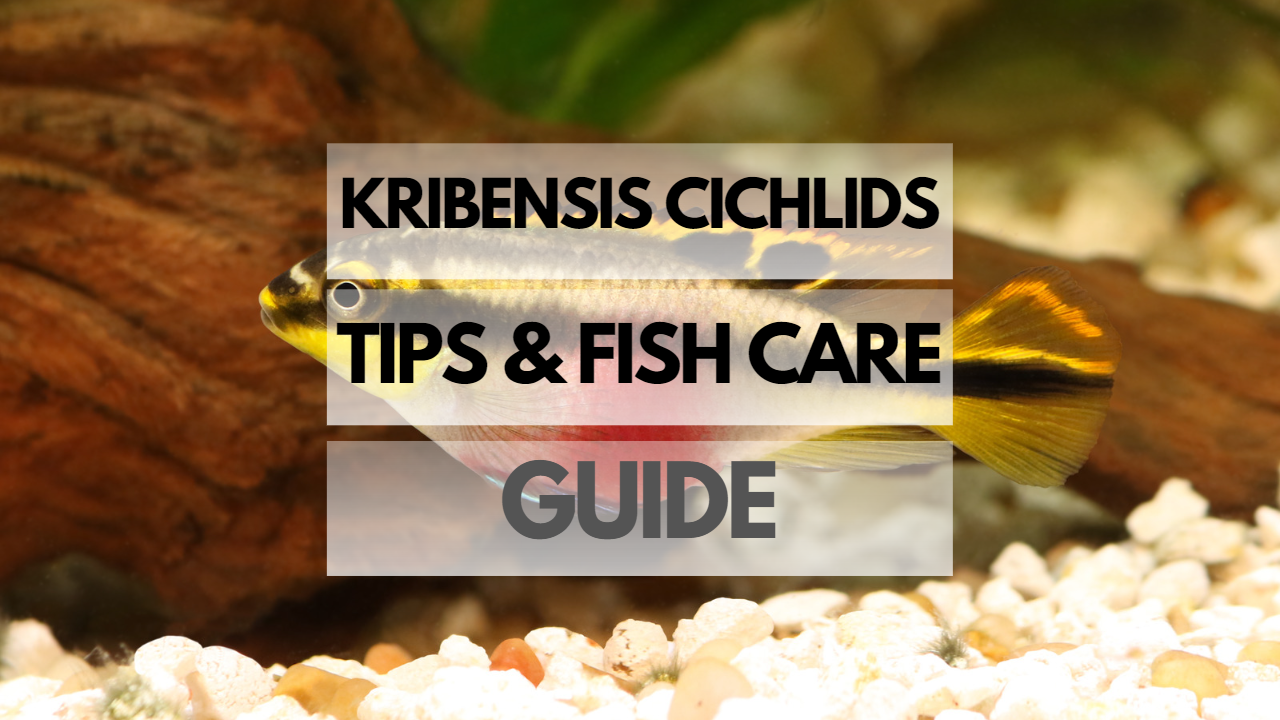Welcome to the complete fish keeping guide for Kribensis Cichlids! These colorful and entertaining fish make great additions to your aquarium. In this guide, well cover everything you need to know about Kribensis Cichlids, from their care requirements to their unique behaviors.
Quick Reference Table: Kribensis Cichlids Facts
| Fact | Details |
|---|---|
| Scientific Name | Pelvicachromis pulcher |
| Ease of Care | Moderate |
| Lifespan | 5-8 years |
| Color Variations | Yellow, orange, and red with blue or green accents |
| Size | 3-4 inches |
| Tank Size | 30 gallons minimum |
| Water Temperature | 75-79°F |
| Food | Omnivorous diet: high-quality pellets, flakes, live, and frozen foods |
| Can Survive in Bowls | No |
| Requires Filter | Yes |
| Requires Heater | Yes |
How Are Kribensis Cichlids as Pets?
Kribensis Cichlids are popular among aquarium enthusiasts for their bright colors, lively personalities, and unique behaviors. As pets, they can be a joy to watch and care for, bringing a touch of the African riverbed to your home.
Are Kribensis Cichlids Easy to Care For?
Kribensis Cichlids have moderate care requirements and are well-suited to intermediate fish keepers. They need a stable environment with proper water parameters, a well-decorated tank, and a varied diet. With proper care, these beautiful fish can thrive in a home aquarium.
Pros and Cons of Kribensis Cichlids
| Pros | Cons |
|---|---|
| Colorful and attractive appearance | Can be territorial, especially when breeding |
| Entertaining behaviors | Not recommended for small tanks or bowls |
| Relatively peaceful for a cichlid | May require a more experienced fish keeper |
| Can be bred in captivity | Requires a varied diet |
How Much Do Kribensis Cichlids Cost?
Kribensis Cichlids typically cost between $5 and $15 per fish, depending on their size, color, and availability. Initial setup costs for a suitable tank, heater, filter, and decorations can range from $200 to $500. Ongoing expenses include food, water treatments, and replacement equipment as needed.
Kribensis Cichlids Lifespan
The average Kribensis Cichlid life expectancy is between 5 and 8 years, with proper care and a suitable environment. As a fish keeper, it’s essential to consider the time commitment involved in providing the best possible care for your Kribensis Cichlids throughout their lives.
Kribensis Cichlids Care Guide
Kribensis Cichlids Habitat and Tank Setup
Appropriate Kribensis Cichlids Tank Size and Type
A minimum 30-gallon tank is recommended for Kribensis Cichlids, with larger tanks being ideal for multiple fish or community setups. Opt for a long, rectangular-shaped tank to provide ample swimming space and areas for the fish to establish territories.
Kribensis Cichlids Water Temperature and Quality
Maintain a stable water temperature between 75-79°F using an aquarium heater. Ensure the water pH is between 6.0 and 7.5, with a hardness of 5-20 dGH. Regularly test the water parameters and perform water changes to maintain a clean, healthy environment.
Filtration and Aeration Requirements
A quality filter is essential for Kribensis Cichlids to remove waste and maintain water clarity. Choose a filter with a flow rate suitable for your tank size. Aeration can be achieved through the filter’s water return, or by adding an air stone to promote oxygen exchange.
Lighting Requirements
Provide moderate lighting for your Kribensis Cichlids, mimicking their natural environment. Use an aquarium light on a timer to establish a consistent day-night cycle, with 10-12 hours of light each day.
Plants for Kribensis Cichlids
Live plants help create a natural environment for Kribensis Cichlids and provide hiding places. Choose hardy plants like Java fern, Anubias, and Vallisneria, which can tolerate the fish’s digging and nesting behaviors.
Substrate, Hideouts and Decorations
Use a fine-grained sand substrate to mimic the Kribensis Cichlids’ natural habitat. Include caves, rocks, and driftwood to create hiding spots and territory boundaries. Arrange the decorations strategically to break up the line of sight and minimize aggression.
Aquarium Cleaning and Maintenance
Perform weekly water tests and regular water changes to maintain optimal water quality. Clean the substrate, glass, and decorations as needed, while being mindful of the fish’s nesting areas. Replace filter media according to the manufacturer’s recommendations.
Kribensis Cichlids Food and Diet
What Do Kribensis Cichlids Eat?
Kribensis Cichlids are omnivores, requiring a varied diet for optimal health. Feed them high-quality pellets or flakes, supplemented with live or frozen foods like brine shrimp, daphnia, and bloodworms. Include occasional vegetable matter such as blanched spinach or zucchini.
Feeding Frequency and Schedule
Feed Kribensis Cichlids 2-3 times a day, offering only what they can consume in 2-3 minutes. Adjust the amount accordingly to prevent overfeeding and maintain water quality.
Kribensis Cichlids Treats
Occasionally offer treats like live blackworms, tubifex worms, or fresh vegetables to supplement their diet and encourage natural foraging behaviors.
Health and Wellness
Common Health Issues
Kribensis Cichlids, like any other fish, can be susceptible to a variety of health issues. Some common problems include Ich, Fin Rot, and Swim Bladder Disease. To prevent these issues, make sure to maintain a clean tank, provide a balanced diet, and monitor the water parameters regularly.
Signs of a Healthy Kribensis Cichlid
| Healthy Kribensis Cichlid | Sick Kribensis Cichlid |
|---|---|
| Active and alert | Lethargic or unresponsive |
| Bright, vibrant colors | Faded or dull colors |
| Clear eyes | Cloudy or swollen eyes |
| Intact fins | Torn or frayed fins |
| Regular appetite | Loss of appetite |
Kribensis Cichlid Breeding
Kribensis Cichlids are relatively easy to breed in a home aquarium. They form monogamous pairs and prefer to breed in caves or other secluded areas. To increase the chances of successful breeding, provide a variety of hiding spots and maintain stable water conditions.
Kribensis Cichlid Tank Mates: Can They Live with Other Fish?
Yes, Kribensis Cichlids can live with other fish, but it’s essential to choose their tank mates carefully. They are generally peaceful but can become territorial, especially during breeding. Suitable tank mates include fish that can tolerate the same water conditions and have a similar temperament, such as tetras, rasboras, and other peaceful cichlids.
Kribensis Cichlid Varieties and Species
There are several varieties of Kribensis Cichlids, each with unique colors and patterns. Some popular varieties include the Super Red, Albino, and Yellow Kribensis Cichlids. It’s essential to research each variety’s specific requirements to ensure you can provide the best care possible.
FAQ for Kribensis Cichlid Care
- Q: Can Kribensis Cichlids live with other fish?
- A: Yes, they can live with other fish, but choose tank mates carefully to avoid aggression or territorial behavior.
- Q: How long do Kribensis Cichlids live?
- A: With proper care, they can live for around 5-8 years.
- Q: How often should I clean my Kribensis Cichlid’s tank?
- A: Perform a 25-30% water change every 2 weeks and clean the tank thoroughly every month.
- Q: Can Kribensis Cichlids change color?
- A: Yes, their colors can become more vibrant during breeding or when displaying dominance.
- Q: Are Kribensis Cichlids good for beginners?
- A: Yes, they are hardy and relatively easy to care for, making them suitable for beginners.
- Q: Do Kribensis Cichlids need a filter?
- A: Yes, a filter is essential for maintaining water quality and removing waste.
- Q: Do Kribensis Cichlids need a heater?
- Q: Can Kribensis Cichlids survive in bowls?
- A: No, bowls are not suitable for Kribensis Cichlids as they require a larger, stable environment with proper filtration and heating.
- Q: Do Kribensis Cichlids sleep?
- A: Yes, they do sleep, usually resting on the bottom of the tank or hiding in a sheltered spot during the night.
- Q: Can Kribensis Cichlids live with snails?
- A: Yes, they can live with snails, as they generally do not show aggression towards invertebrates.
A: Yes, a heater is necessary to maintain a stable temperature between 75-79°F (24-26°C).

